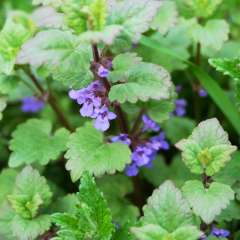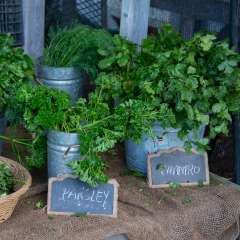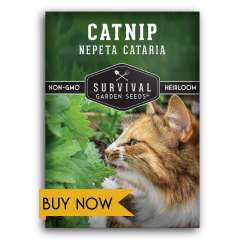Catnip and other pet-safe herbs offer a range of benefits for your pets, including stress relief, digestive support, and insect repellent properties. Catnip is a member of the mint family, is easy to grow, and will thrive indoors in a container or outdoors in the garden. By learning how to grow these herbs, you can provide your pets with natural remedies and enhance their overall well-being.
Catnip From Seed to Harvest
Planting Catnip Seeds
If you want to grow catnip from seed, there are a couple of important steps you need to take for successful germination. Catnip seeds have a tough outer shell coat, so they need to be stratified before planting. What this means is that the seed shell needs to be slightly damaged before it will sprout. An easy way to do this is to sprinkle seeds onto a damp paper towel, roll it up, and store it in the refrigerator inside a plastic bag for 2-3 weeks. A faster way is to freeze the seeds overnight and then soak them in water for 24 hours before planting.
Once seeds have been stratified, they can be planted indoors or outdoors. If planting outdoors, wait until after the last chance of frost in the Spring. Plant seeds about 1/8 of an inch deep and keep moist until germination. Seedlings should be thinned to about 12 to 18 inches apart.
Growing Catnip
Catnip grows best in full sun and does not require much watering. If growing outdoors, you may only have to water your plants during drought conditions. Catnip proliferates quickly and does not need fertilizer. Planting in sandy soil will enhance the aroma of the catnip plant.

Like other mints, catnip can be invasive. To prevent aggressive spread, you can plant your herbs in containers or remove the flowers before they go to seed. Prune your plant often to help maintain good air circulation and prevent dense overgrowth in the middle of the plant. This will help to prevent powdery mildew.
Harvesting Catnip
Catnip leaves can be harvested at any point during the growing season. If you want to prevent catnip from re-seeding and spreading, you should continuously dead-head flowers shortly after they open and before they can go to seed. You can remove individual leaves and flowers or cut whole stems for use.
Using Catnip for Cats and Humans
Your kitty will love rolling around and nibbling on fresh catnip leaves. Catnip contains a compound called nepetalactone that sets off a euphoric reaction when cats lick and rub the herb. Interestingly, eating the herb tends to calm a cat down, while the scent of the herb stimulates them. The leaves can be dried and used to stuff toys. While there is no real difference between fresh and dried catnip leaves, fresh tends to be more potent and your cat may prefer one version or the other.
Catnip has natural insect-repelling properties which may be one reason cats evolved to be attracted to this plant for natural protection from ticks and fleas. Humans can take advantage of these properties by growing catnip around your patio or on your deck to help keep away mosquitoes and other insects.
You can also enjoy catnip in a soothing tea made from flowers and leaves. Catnip tea has been used for hundreds of years to treat intestinal issues and the common cold. A poultice of leaves can be used to reduce swelling. Catnip hair rinses are a popular, natural method of softening hair and helping to reduce split ends.
Other Pet-Safe Herbs to Grow

There are lots of other herbs that both you and your furry companions can enjoy. Here are just a few herbs that are known to be safe and beneficial for cats and dogs. Use them on their own, not mixed with other human foods, for safety reasons.
- Basil - Basil is known for its anti-inflammatory properties. It contains essential oils that can help with digestion and reduce stress in pets.
- Cilantro - Cilantro is an excellent source of vitamins A and C and can help with an upset stomach.
- Parsley - Parsley is a popular pet-friendly herb. It contains immune-boosting antioxidants and can help freshen your pet's breath.
- Rosemary - Rosemary is not toxic to cats or dogs. It can be used to create a natural flea repellent by steeping a large handful of rosemary sprigs in boiling water for 30 minutes. Once cool, saturate your pet’s coat with the rosemary water.
- Sage - Sage has antibacterial and antifungal properties that help prevent infections and can promote your pet’s overall health.
- Thyme - Thyme is a good source of fiber and is rich in vitamins A, C, and K to promote healthy immune function.
Growing catnip and other herbs can provide health benefits for both you and your cats and dogs. Herbs are easy to grow and most will thrive in containers indoors so they are easy to access year round. Why not share the joy of your garden with your pet?
























